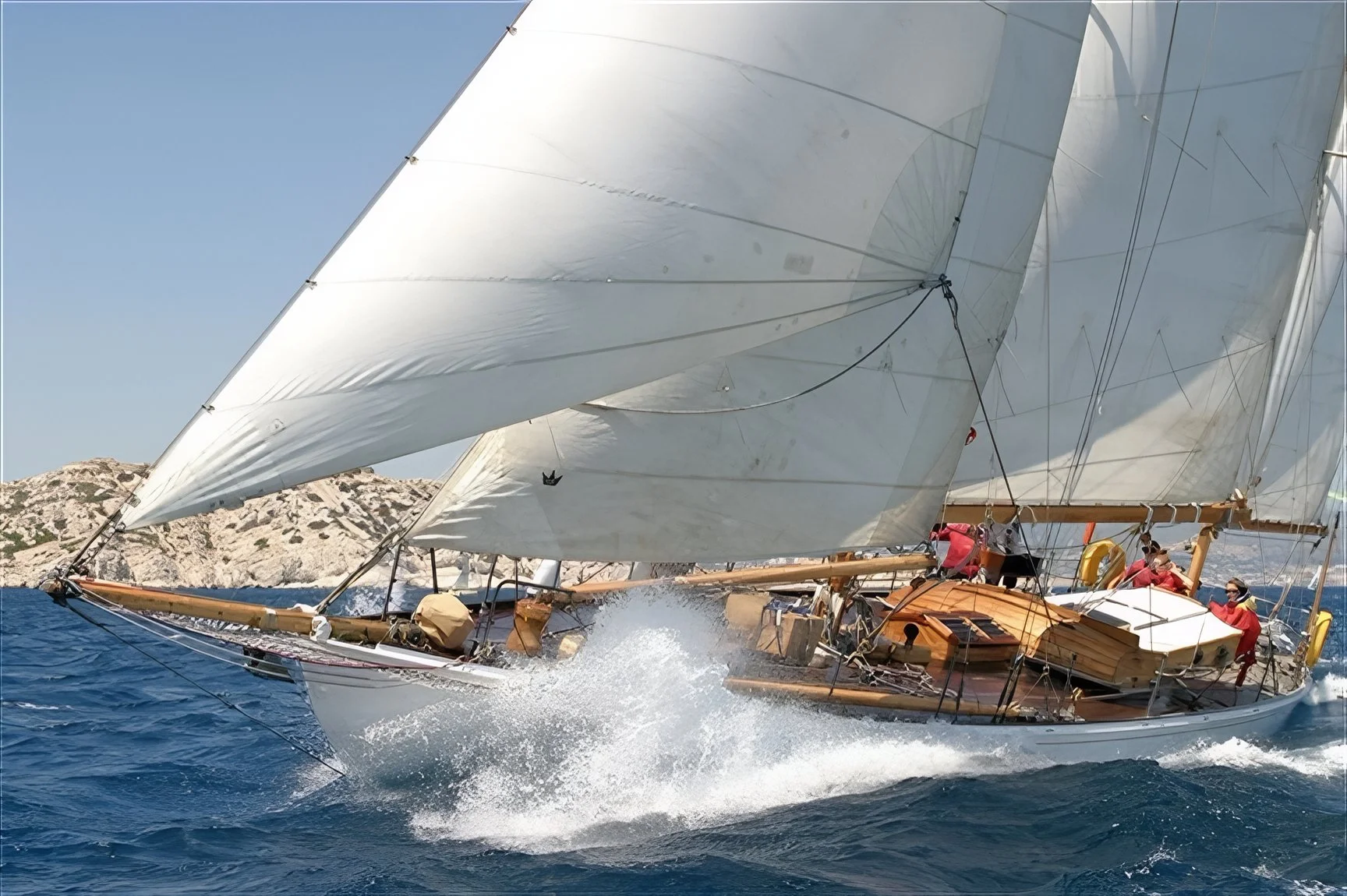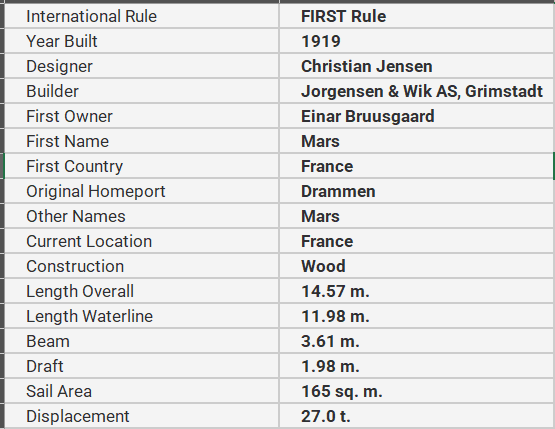
Skøiern
Mars/Skøiern(1917) – A 12 Metre Spissgatter
Origins in Grimstad (1917–1918)
The yacht Mars, a 12 Metre spissgatter, was built in Grimstad, on the southern coast of Norway, between 1917–1918 by boatbuilders Jørgensen og Viik, a yard that still exists today as a museum. She was designed by the renowned naval architect Christian Jensen, celebrated for his seaworthy double-ended hulls perfected alongside Colin Archer. The cost of the yacht at launch was NOK 45,000, an enormous sum at the time.
Unlike many 12 Metres built for competition, Mars was designed strictly as a cruising vessel. Shortly after her commissioning by Einaar Bruusgaard of Drammen, a sistership named Lady III was ordered by Bruusgaard’s friend Mr. Mohn. Lady III, launched in 1919, went on to a long and eventful life of her own, restored and modernized by later owners.
Early Years with the Bruusgaard Family
Under Bruusgaard’s ownership, Mars cruised extensively in Norwegian, Swedish, and Danish waters. She carried no engine, instead towing a mahogany dinghy fitted with an unreliable outboard motor, often used as a tug during calms.
Around 1926, she was rerigged: her boom was shortened, her bowsprit removed, and her sail area reduced. Despite this, her mast snapped in a gale soon after, requiring a replacement within the same season.
Maintained by professional boatmen in Husø near Tønsberg, Mars was kept in immaculate condition. The crew doubled as cooks, tenders, and sailors, sleeping in pipecots forward of the galley. She was registered in the Royal Norwegian Yacht Club (KNS), flying its distinctive flag with the royal emblem, though she appeared rarely in official yearbooks since she was not a racing yacht.
In the depths of the economic depression, around 1933–34, Mars was sold for just NOK 8,000—fully outfitted with sails, china, and carpets, far less than the value of her gear alone.
Bruusgaard & Kløsterud Legacy
Einaar Bruusgaard (1882–1957), owner of Mars, was also co-founder of the shipping company Bruusgaard & Kløsterud in Drammen, one of Norway’s leading firms of the early 20th century. His son, Einaar Jr. (1909–2001), later succeeded him as company president. Passionate about outdoor sports but less fond of sailing, he left behind many letters and photographs recounting Mars’s history to Ulf Brudevoll in 1992, preserving invaluable details of her early years.
From Norway to France – Becoming Skøiern (1933–1940s)
By 1933, Mars had been sold abroad, registered in Le Havre, and renamed Skøiern, meaning “Mischievous” in Norwegian. Soon after, she was re-rigged as a Bermudian cutter, and in 1933 her mast broke near the top. That same year she received her first auxiliary engine, a 12/15 hp Ballot gasoline motor.
During World War II, in 1940, Skøiern was requisitioned by the Germans and stationed in Lézardrieux. Roughly handled, she was damaged while being beached with poles and even attacked with an incendiary grenade, though she survived. By 1942, she was returned to her owners and anchored at Paimpol.
Post-War Transformations (1948–1970s)
After the war, Skøiern passed through several French owners. In 1948 she was auctioned, bought by Louis Rivière, and underwent heavy work: a new Oregon pine mast, keel bolt replacements, and extensive hull repairs.
By the 1960s, she was rebuilt again: a new iroko deck was fitted in 1964, and in 1968–69 Rivière converted her into a ketch, stepping a mizzen mast from Pen Duick III and a spruce main mast by Craff.
Ownership changed hands several times in the 1970s. Her Ferguson gasoline engine was replaced with a 55 hp RMC diesel, marking her full transition into a long-distance cruising yacht.
Mediterranean Years (1980s–2000)
By the late 1970s and early 1980s, Skøiern was based in Marseille. After six years of work, she sailed again in 1986. In 2000, she participated in France’s great maritime gatherings at Brest, Douarnenez, and Ushant, before cruising to the Azores.
The Great Voyage (2006–2019)
In June 2006, Skøiern embarked on a vast Atlantic and world voyage. Her course included Madeira, the Azores, Brittany, Norway, Galicia, Morocco, Cape Verde, Senegal, Brazil, Uruguay, Argentina, the Falklands, the Caribbean, Panama, Easter Island, the Marquesas, Alaska, California, and Mexico—covering more than 54,000 nautical miles over eight years.
In 2019, she celebrated her centenary with festivities in Port Lay on the Île de Groix and back in Grimstad, Norway, alongside her sistership Lady.
Recent Restorations (2004–2023)
Over the past two decades, Skøiern has undergone extensive structural renewals in France, Canada, and Norway. Planking, frames, and keel bolts have been replaced, hulls recaulked, and a new saloon and dinghy crafted. In 2023, she entered Pôle Belle Plaisance in Douarnenez, her current homeport, for further refit and maintenance.
Legacy of Mars / Skøiern
From her birth in Norway as Mars—a luxurious spissgatter built for cruising—to her wartime ordeals, Mediterranean voyages, transatlantic crossings, and her remarkable circumnavigation, she embodies a century of adventure.
Today, under the name Skøiern, she is recognized as a unique survivor: the largest 12 Metre spissgatter ever built, and a living testament to the enduring seaworthiness of Norwegian double-ended yachts.

